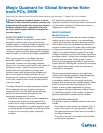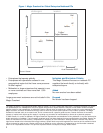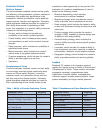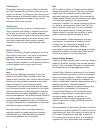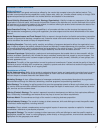
4
Challengers
Challengers have high scores in Ability to Execute,
but their Completeness of Vision scores are not as
high as the leaders. Challengers often have a good
market presence and financial stability, but they may
have less geographic coverage or they lack an
innovative view of the products.
Visionaries
Visionaries have high scores in Completeness of
Vision; however, their Ability to Execute scores are
not as high as vendors in the Leaders quadrant.
Their market presence may be less than the leaders,
and their financial stability may not be as solid. Also,
their sales organization and customer support
mechanism my not be as comprehensive as the
leaders.
Niche Players
Vendors in the Niche Players quadrant do not have
high scores in both axes. They have a low market
presence, and market coverage is limited.
Meanwhile, they may specialize in particular areas in
a vertical-market segment or have product portfolios
in which leaders may not have much focus.
Vendor Comments
Acer
Acer is in the Challengers quadrant, but on the
border of the Niche Players quadrant. Acer has
global product offerings, with a highly efficient supply
chain and a strong market presence across many
regions. However, its core business targets
transactional customers (small business and retail),
and its business model is not focused on the higher-
volume requirements of large-enterprise customers.
Global service and support capabilities, as well as
account management, are far below those offered by
the market leaders. Acer’s lack of investment in
these enterprise capabilities limits our evaluation of
its ability to execute and completeness of vision as a
potential enterprise notebook supplier.
Recommendation: Acer is recommended as a
potential supplier for global enterprise notebook
requirements only if standardization and global
account management are not required.
Dell
Dell’s scores for Ability to Execute are the highest
among all notebook vendors. Dell has an excellent
supply chain for notebook products and strong
marketing execution capabilities. Dell achieved the
highest overall viability score and remains the leader
in service and support for the largest global
enterprises. However, for smaller enterprises that do
not achieve “global account status” with Dell, the
level of service is often less. For such customers,
service and support may be inconsistent across
different regions, ranging from excellent in some
mature markets to barely adequate in others.
Recommendation: Global enterprises and large
organizations (irrespective of location) should
consider Dell as a prospective supplier for all
business notebook requirements. Midsize
organizations, especially those operating in multiple
geographic locations, should expect Dell’s level of
service and support to be less consistent.
Fujitsu/Fujitsu Siemens
Fujitsu and Fujitsu Siemens offer a common range of
global PC products, although they are two separate
entities. Thus, this Magic Quadrant evaluates these
two companies as a single aggregate vendor.
Fujitsu/Fujitsu Siemens is positioned in the Leaders
quadrant although its position is close to the border
of the visionaries quadrant. Fujitsu/Fujitsu Siemens
offers a range of quality enterprise notebooks. Its
ability to understand customer needs matches that of
leading competitors. Customer feedback
mechanisms and appropriate service offerings are
integrated into its operation. A challenge for
Fujitsu/Fujitsu Siemens is its inconsistent global
presence, which results in inconsistent levels of
services between regions. In particular, its
capabilities in North America lag those in other
regions, particularly Europe, the Middle East and
Africa (EMEA).
Recommendation: Fujitsu/Fujitsu Siemens should be
considered for global notebook PC contracts only by
organizations for which the majority of users are not
U.S.-based. Organizations with high numbers of
U.S.-based users should consider it as a potential
supplier only if they have some other compelling



